Debate Practice for Japanese Students: 日本人学生のディベート実践 [Report]
Debate Practice for Japanese Students in Silicon Valley, California
カリフォルニア・シリコンバレーでの日本人学生のディベート実践
Date: March 20-21, 2017; 日時:2017年3月20日~21日
Place: Pacific Motor Inn, San Jose, California: 場所:カリフォルニア・サンノゼ
Program: Kyushu Univ 5 week ELEP program: プログラム:九州大学5週間海外研修
A group of students from Kyushu University practiced a "formal debate" in the final week of their training program, organized by the Kyushu Univ. office in Silicon Valley, California.
Two important issues, AI (artificial intelligence) and nuclear energy, are taken up in the debate, first in Japanese on March 20, and then in English on March 21.
"Learning by doing" was the approach taken here, as this was a new experience for most students.
In this two-day practice, the students were offered opportunities to learn many things, from English to debate manner in addition to the issues themselves. In fact, on this program, especially in the debate practice, all the students made really impressive progress in the presentation and exchange of their opinions in Japanese and English as well.
For more details about the issues, see the reference at the bottom of this page.
九州大学カリフォルニア・シリコンバレーオフィスの研修に参加した学生たちによるディベートの実践。
2つの重要なイシューが取り上げられた:AI(人工知能)と原発問題。
初日(3月20日)は日本語で、翌日(3月21日)には英語で実施。
ほとんどの学生にとって公式ディベートは初めてだったこともあり「やりながら学ぶ」という方法をとり、イシューそのものに加えて英語からディベートのマナーにいたる多くことを学ぶ機会が提供された。
実際にこの研修プログラム、特にディベート実践によって、すべての学生が日本語および英語で自分の意見を表明し討論する能力と態度について目覚ましい進歩を遂げたといえる。
イシューの内容については、一番下の「参考」に掲載。
Program coordinator M. Matsuo introducing debate instructor T. Miyao
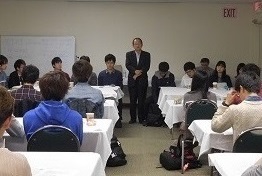
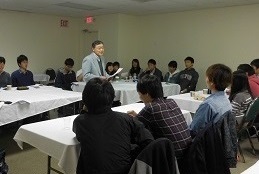
Students' debate on nuclear energy: "Pro" side (left) vs. "Con" side (right)
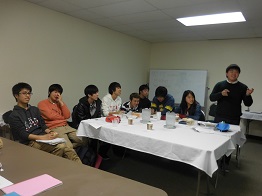
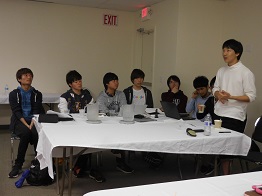
Final comments by Prof. Takamatsu and Group photo of all participants
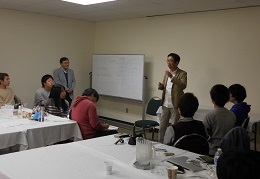
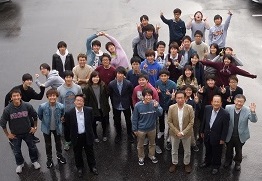
Reference; 参考:
Distribution material handed out to students prior to the debate
ディベート用に事前に学生たちに配布された参考資料
イシュー1:AI(人工知能)の将来は我々人間にとって福音か脅威か。あなたは推進派か慎重派か。
Issue 1: Is the future of AI likely a blessing or a threat for human beings? Are you bullish or cautious about the future of AI?
サイドA:推進派の立場:
AIの進歩はめざましく、我々の生活や仕事を根本から変えつつある。それはすでに情報、金融、商業などのサービスがますます便利になっていることに示されている。生産性も生活水準もAIの発展に伴って著しく改善するので、もっとも進歩したAIを持つ者が世界の将来を左右することになるであろう。
Side A: AI is advancing and helping our life and work significantly, as already shown in ever more convenient services in information, financial and retail business. Our productivity and living standard will be improved substantially with the development of AI, and those who possess the most advanced AI will prevail in the world in the future.
サイドB:慎重派の立場:
AIは誰の予想よりも速く進歩していて、すでに我々の仕事をかなり奪いつつあり、先端的な産業でさえも倒産、失業、低賃金などの深刻な問題を生み出している。そのような産業は実は最先端のAI技術を持つ数少ない巨大企業によって支配されている。その上、AIは間もなく「シンギュラりティー点」を超えて、人間がコントロールできなくなり、破壊的な結果をもたらす可能性がある。
Side B: AI is advancing itself faster than anyone has predicted, already replacing some workers and creating serious problems such as bankruptcies, unemployment and low wages even in advanced industries, which are now dominated by few giant companies with advanced AI technology. Furthermore, AI is bound to reach the "singularity point" beyond which AI could be uncontrollable and disastrous for human beings.
イシュー2:原発は、我々のエネルギー、技術、環境などのニーズの観点から必要か不必要か。あなたは原発に賛成ですか反対ですか。
Issue 2: Is nuclear power necessary or unnecessary to satisfy our needs for energy, technology, the environment, etc. Are you for or against nuclear energy?
サイドA:賛成派の立場:
資源に乏しい日本のような国では、原発がエネルギーと環境のニーズの両立というジレンマに応えるために、石炭、石油、天然ガスという化石燃料に対する唯一の現実的な代替エネルギーであり、クリーンな再生可能資源がまだエネルギー供給のごく僅かな部分にしか過ぎず、しかもコストが上昇している状況では特にそうである。原発の安全問題は、国際協力によって最新でより安全な原発技術の開発と投資によって対処する以外にない。
Side A: In a country like Japan without much natural resources, nuclear power is the only realistic alternative to fossil fuels such as oil, coal and natural gas, to reconcile the dilemma to satisfy both energy and environmental needs, as clean renewable resources are still a tiny fraction of energy supply with rising costs. The nuclear safety issue can only be addressed by international cooperation to develop and invest in newer and safer nuclear power technology.
サイドB:反対派の立場:
一国がエネルギーのニーズを満たすために、原発に依存するのは、あまりに深刻な問題があり危険なことである。コスト面でも、原子力発電所を稼働されるために必要な安全上の措置を考えても、もちろん原発事故が起こった時の膨大な費用を考慮しても高すぎる。さらに深刻なのは、核廃棄物の問題で、その処理は既存の技術では可能でないことである。原発なしにはエネルギー不足が短期的には避けられないが、クリーンな再生可能エネルギーを奨励して長期的なニーズを満たす以外にない。
Side B: Nuclear energy is too hazardous and dangerous for any country to rely on to satisfy its energy needs, and also it is too costly in view of all the safety measures required for nuclear power plant operations and, most of all, enormous costs imposed on society in case of accident. Equally serious is the nuclear waste issue, which cannot be treated with existing technologies. Although, without nuclear power, energy shortage may be unavoidable in the short run, clean renewable energy should be encouraged to meet the long-run energy needs.
------------------------------------------------------------------------------------------
カリフォルニア・シリコンバレーでの日本人学生のディベート実践
Date: March 20-21, 2017; 日時:2017年3月20日~21日
Place: Pacific Motor Inn, San Jose, California: 場所:カリフォルニア・サンノゼ
Program: Kyushu Univ 5 week ELEP program: プログラム:九州大学5週間海外研修
A group of students from Kyushu University practiced a "formal debate" in the final week of their training program, organized by the Kyushu Univ. office in Silicon Valley, California.
Two important issues, AI (artificial intelligence) and nuclear energy, are taken up in the debate, first in Japanese on March 20, and then in English on March 21.
"Learning by doing" was the approach taken here, as this was a new experience for most students.
In this two-day practice, the students were offered opportunities to learn many things, from English to debate manner in addition to the issues themselves. In fact, on this program, especially in the debate practice, all the students made really impressive progress in the presentation and exchange of their opinions in Japanese and English as well.
For more details about the issues, see the reference at the bottom of this page.
九州大学カリフォルニア・シリコンバレーオフィスの研修に参加した学生たちによるディベートの実践。
2つの重要なイシューが取り上げられた:AI(人工知能)と原発問題。
初日(3月20日)は日本語で、翌日(3月21日)には英語で実施。
ほとんどの学生にとって公式ディベートは初めてだったこともあり「やりながら学ぶ」という方法をとり、イシューそのものに加えて英語からディベートのマナーにいたる多くことを学ぶ機会が提供された。
実際にこの研修プログラム、特にディベート実践によって、すべての学生が日本語および英語で自分の意見を表明し討論する能力と態度について目覚ましい進歩を遂げたといえる。
イシューの内容については、一番下の「参考」に掲載。
Program coordinator M. Matsuo introducing debate instructor T. Miyao


Students' debate on nuclear energy: "Pro" side (left) vs. "Con" side (right)


Final comments by Prof. Takamatsu and Group photo of all participants


Reference; 参考:
Distribution material handed out to students prior to the debate
ディベート用に事前に学生たちに配布された参考資料
イシュー1:AI(人工知能)の将来は我々人間にとって福音か脅威か。あなたは推進派か慎重派か。
Issue 1: Is the future of AI likely a blessing or a threat for human beings? Are you bullish or cautious about the future of AI?
サイドA:推進派の立場:
AIの進歩はめざましく、我々の生活や仕事を根本から変えつつある。それはすでに情報、金融、商業などのサービスがますます便利になっていることに示されている。生産性も生活水準もAIの発展に伴って著しく改善するので、もっとも進歩したAIを持つ者が世界の将来を左右することになるであろう。
Side A: AI is advancing and helping our life and work significantly, as already shown in ever more convenient services in information, financial and retail business. Our productivity and living standard will be improved substantially with the development of AI, and those who possess the most advanced AI will prevail in the world in the future.
サイドB:慎重派の立場:
AIは誰の予想よりも速く進歩していて、すでに我々の仕事をかなり奪いつつあり、先端的な産業でさえも倒産、失業、低賃金などの深刻な問題を生み出している。そのような産業は実は最先端のAI技術を持つ数少ない巨大企業によって支配されている。その上、AIは間もなく「シンギュラりティー点」を超えて、人間がコントロールできなくなり、破壊的な結果をもたらす可能性がある。
Side B: AI is advancing itself faster than anyone has predicted, already replacing some workers and creating serious problems such as bankruptcies, unemployment and low wages even in advanced industries, which are now dominated by few giant companies with advanced AI technology. Furthermore, AI is bound to reach the "singularity point" beyond which AI could be uncontrollable and disastrous for human beings.
イシュー2:原発は、我々のエネルギー、技術、環境などのニーズの観点から必要か不必要か。あなたは原発に賛成ですか反対ですか。
Issue 2: Is nuclear power necessary or unnecessary to satisfy our needs for energy, technology, the environment, etc. Are you for or against nuclear energy?
サイドA:賛成派の立場:
資源に乏しい日本のような国では、原発がエネルギーと環境のニーズの両立というジレンマに応えるために、石炭、石油、天然ガスという化石燃料に対する唯一の現実的な代替エネルギーであり、クリーンな再生可能資源がまだエネルギー供給のごく僅かな部分にしか過ぎず、しかもコストが上昇している状況では特にそうである。原発の安全問題は、国際協力によって最新でより安全な原発技術の開発と投資によって対処する以外にない。
Side A: In a country like Japan without much natural resources, nuclear power is the only realistic alternative to fossil fuels such as oil, coal and natural gas, to reconcile the dilemma to satisfy both energy and environmental needs, as clean renewable resources are still a tiny fraction of energy supply with rising costs. The nuclear safety issue can only be addressed by international cooperation to develop and invest in newer and safer nuclear power technology.
サイドB:反対派の立場:
一国がエネルギーのニーズを満たすために、原発に依存するのは、あまりに深刻な問題があり危険なことである。コスト面でも、原子力発電所を稼働されるために必要な安全上の措置を考えても、もちろん原発事故が起こった時の膨大な費用を考慮しても高すぎる。さらに深刻なのは、核廃棄物の問題で、その処理は既存の技術では可能でないことである。原発なしにはエネルギー不足が短期的には避けられないが、クリーンな再生可能エネルギーを奨励して長期的なニーズを満たす以外にない。
Side B: Nuclear energy is too hazardous and dangerous for any country to rely on to satisfy its energy needs, and also it is too costly in view of all the safety measures required for nuclear power plant operations and, most of all, enormous costs imposed on society in case of accident. Equally serious is the nuclear waste issue, which cannot be treated with existing technologies. Although, without nuclear power, energy shortage may be unavoidable in the short run, clean renewable energy should be encouraged to meet the long-run energy needs.
------------------------------------------------------------------------------------------
Story for Disaster Prevention Education in : 防災教育のための物語 [Information 情報]
Disaster Prevention Education Based on Lafcadio Hearn’s Story
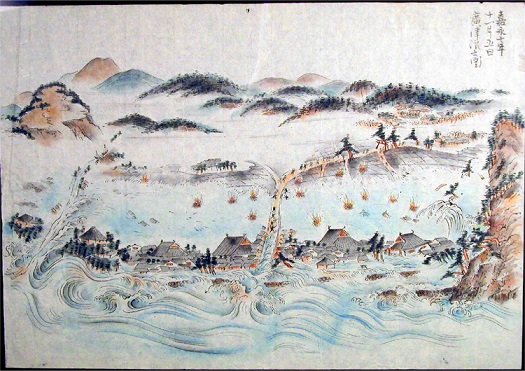
In the period 1937-1947, disaster prevention education, especially about Tsunami, was widely given in Japan, using a textbook based on Lafcadio Hearn’s “A Living God,” that is a story of Gohei Hamada, who set fire to his rice heads on a high hillside to attract village people for fire fighting, thus saving them from the great tsunami, which happened in 1896 (Meiji Sanriku Earthquake)
Reference: Lafcadio Hearn "A Living God": http://inamuranohi.jp/a-living-god/
Note: Lafcadio Hearn, born in Greece (1850), migrated to Ireland (1982), moved to the US (1859), and lived in Japan (1890-1904), published "A Living God" in 1897, a year after the Meiji Sanriku Earthquake.
---------------------------------------------------------------------------------
小泉八雲(ラフカディオ・ハーン)の物語による防災教育
1896年の明治三陸地震・津波で「村の長者の浜田五兵衛が高台の自分の稲むらに火をつけ、それを消しに駆け付けた村人たちを大津波から救った」という話『A living God』(小泉八雲著・英文)を元にした教材『稲むらの火』が、昭和12~22年に防災教育に広く使われた。
参考:『天災と日本人』(畑中章宏著)2017年2月
「稲むらの火」: http://inamuranohi.jp/
------------------------------------------------------------------------------------

In the period 1937-1947, disaster prevention education, especially about Tsunami, was widely given in Japan, using a textbook based on Lafcadio Hearn’s “A Living God,” that is a story of Gohei Hamada, who set fire to his rice heads on a high hillside to attract village people for fire fighting, thus saving them from the great tsunami, which happened in 1896 (Meiji Sanriku Earthquake)
Reference: Lafcadio Hearn "A Living God": http://inamuranohi.jp/a-living-god/
Note: Lafcadio Hearn, born in Greece (1850), migrated to Ireland (1982), moved to the US (1859), and lived in Japan (1890-1904), published "A Living God" in 1897, a year after the Meiji Sanriku Earthquake.
---------------------------------------------------------------------------------
小泉八雲(ラフカディオ・ハーン)の物語による防災教育
1896年の明治三陸地震・津波で「村の長者の浜田五兵衛が高台の自分の稲むらに火をつけ、それを消しに駆け付けた村人たちを大津波から救った」という話『A living God』(小泉八雲著・英文)を元にした教材『稲むらの火』が、昭和12~22年に防災教育に広く使われた。
参考:『天災と日本人』(畑中章宏著)2017年2月
「稲むらの火」: http://inamuranohi.jp/
------------------------------------------------------------------------------------
Stanford Seminar on China in South Asia on Feb. 21, 2017 [Report]
Stanford Seminar: "China in South Asia's New Strategic Quadrangle"
Date/Time: February 21(T), 2017, 4:30-6:00pm
Venue: Philippines Conference Room, Encina Hall, Stanford
Sponsored by: Shorenstein Asia-Pacific Research Center
Speaker: Evan A. Feigenbaum, Vice Chairman, The Paulson Institute
Webpage: http://fsi.stanford.edu/events/china-south-asia%E2%80%99s-new-strategic-quadrangle
"South Asia is one of the least economically integrated regions of the world, but its future can no longer be divorced from broader trends in a dynamic, volatile, yet increasingly integrated Asia........ In this talk, Feigenbaum will explore China's changing role in South Asia but especially the complex interaction there among four big powers ("Asia's new strategic quadrangle) - India, China, the US, and Japan"
Dr. Evan Feigenbaum's talk and Q&A session
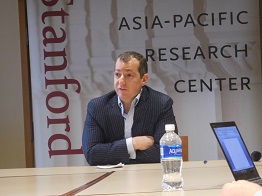
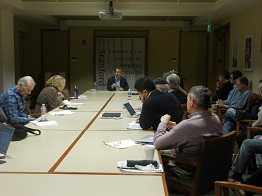
Comment: Despite its regionally focused title, the actual talk encompassed a whole range of strategic and economic changes in Asia and the Pacific rim. A strong message of the speaker emerged toward the end of his talk, especially during the Q&A session, that there seems to be no single, unified policy approach to various countries and regions on the part of China to dominate the whole region or the world for that matter, as is often feared by Western observers. This means that even if the US withdraws from some of the region-wide activities in Asia Pacific such as TPP, China could not automatically become the dominant strategic and economic power in the region; an "anti-alarmist" argument which reminds us of Dr. Harold Trinkunas' seminar on "China's role in Latin America" at Stanford on Feb. 1, 2017. See the following report:
Harold Trinkunas (Center for Int'l Security & Cooperation, Stanford) "A 'Comprehensive and Cooperative Partnership'?: Assessing China's Role in Latin America"
http://miyao-blog.blog.so-net.ne.jp/2017-02-02
(Takahiro Miyao)
-----------------------------------------------------------------------------------
Date/Time: February 21(T), 2017, 4:30-6:00pm
Venue: Philippines Conference Room, Encina Hall, Stanford
Sponsored by: Shorenstein Asia-Pacific Research Center
Speaker: Evan A. Feigenbaum, Vice Chairman, The Paulson Institute
Webpage: http://fsi.stanford.edu/events/china-south-asia%E2%80%99s-new-strategic-quadrangle
"South Asia is one of the least economically integrated regions of the world, but its future can no longer be divorced from broader trends in a dynamic, volatile, yet increasingly integrated Asia........ In this talk, Feigenbaum will explore China's changing role in South Asia but especially the complex interaction there among four big powers ("Asia's new strategic quadrangle) - India, China, the US, and Japan"
Dr. Evan Feigenbaum's talk and Q&A session


Comment: Despite its regionally focused title, the actual talk encompassed a whole range of strategic and economic changes in Asia and the Pacific rim. A strong message of the speaker emerged toward the end of his talk, especially during the Q&A session, that there seems to be no single, unified policy approach to various countries and regions on the part of China to dominate the whole region or the world for that matter, as is often feared by Western observers. This means that even if the US withdraws from some of the region-wide activities in Asia Pacific such as TPP, China could not automatically become the dominant strategic and economic power in the region; an "anti-alarmist" argument which reminds us of Dr. Harold Trinkunas' seminar on "China's role in Latin America" at Stanford on Feb. 1, 2017. See the following report:
Harold Trinkunas (Center for Int'l Security & Cooperation, Stanford) "A 'Comprehensive and Cooperative Partnership'?: Assessing China's Role in Latin America"
http://miyao-blog.blog.so-net.ne.jp/2017-02-02
(Takahiro Miyao)
-----------------------------------------------------------------------------------
"How to Debate" for Students from Kyushu U.: 九大生のための「ディベートの仕方」 [Report]
Lecture on "How to Debate" for Students from Kyushu U.@SJSU Campus
九大生グループのための「ディベートのやり方」の講義@サンノゼ州立大学キャンパス
Date/Time: 2/21(T), 2017, 1:30-2:15pm; 日時 2月21日(火)13:30~14:15
Place: SJSU Engineering Building: 場所 サンノゼ州立大学・工学部ビル
A brief instruction about "how to debate" was given to a group of students from Kyushu University, participating in their five-week training program in Silicon Valley. Their actual debate exercise will be held in late March.
シリコンバレーで5週間の研修を受けている九州大学の学生たちに「ディベートのやり方」についての講義があった。ディベートの実習は3月後半に実施される予定。
SJSU Campus Scene; サンノゼ州立大学のキャンパス風景
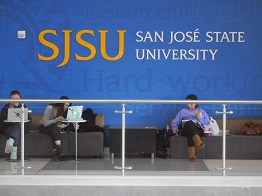
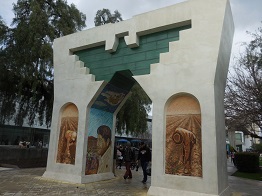
Engineering Building & Student Union; 工学部ビルと学生食堂周辺の様子
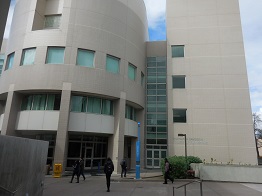
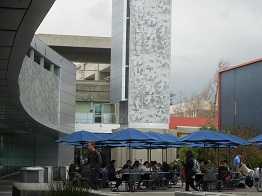
Dr Matsuo's introduction & Dr Miyao's lecture; 松尾氏による紹介と宮尾氏の講義
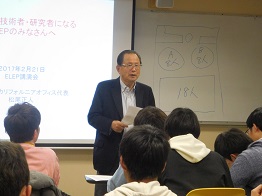
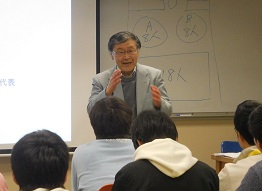
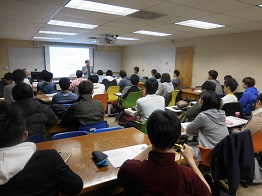

References; 参考
1. "Debate Manual" (Illustrations by T. Miyao): https://youtu.be/xfLQAUzikkQ
2. 「ディベートの手引き」(絵・宮尾尊弘): https://youtu.be/4V9tlXwtypo
----------------------------------------------------------------------------------------
九大生グループのための「ディベートのやり方」の講義@サンノゼ州立大学キャンパス
Date/Time: 2/21(T), 2017, 1:30-2:15pm; 日時 2月21日(火)13:30~14:15
Place: SJSU Engineering Building: 場所 サンノゼ州立大学・工学部ビル
A brief instruction about "how to debate" was given to a group of students from Kyushu University, participating in their five-week training program in Silicon Valley. Their actual debate exercise will be held in late March.
シリコンバレーで5週間の研修を受けている九州大学の学生たちに「ディベートのやり方」についての講義があった。ディベートの実習は3月後半に実施される予定。
SJSU Campus Scene; サンノゼ州立大学のキャンパス風景


Engineering Building & Student Union; 工学部ビルと学生食堂周辺の様子


Dr Matsuo's introduction & Dr Miyao's lecture; 松尾氏による紹介と宮尾氏の講義




References; 参考
1. "Debate Manual" (Illustrations by T. Miyao): https://youtu.be/xfLQAUzikkQ
2. 「ディベートの手引き」(絵・宮尾尊弘): https://youtu.be/4V9tlXwtypo
----------------------------------------------------------------------------------------
Revisit to SF Bay Area (2017/1/31-2/2): SFベイエリア再訪 [Report]
Visit to SF Bay Area (1/31-2/2, 2017): SFベイエリア訪問(2017/1/31-2/2)
Main purposes: To give a "Certificate of Appreciation" to outgoing JUNBA Chair & Osaka Univ. office head Mr. Kabasawa, and consult with Kyushu Univ. office head Mr. Matsuo about my upcoming debate class for his student group, as well as to attend three Stanford seminars on Japan and China.
訪問の主目的: 間もなくJUNBA(ベイエリア大学ネットワーク)代表と阪大北米センター長の職を退く樺澤氏に「感謝状」を贈呈し、また九大カリフォルニアオフィス代表の松尾氏とディベート実施について相談するとともに、日本と中国に関する3つのスタンフォード大セミナーに参加すること。
Day 1: January 31(T) ; 1日目:1月31日(火)
Revisiting Osaka Univ. Office in SF: 大阪大学北米センター・樺澤氏再訪
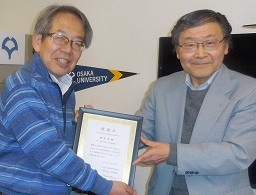
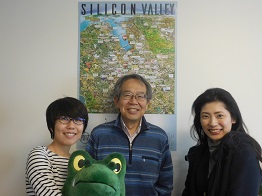
Revisiting JSPA Office in Berkeley: JSPSオフィス・田宮氏再訪
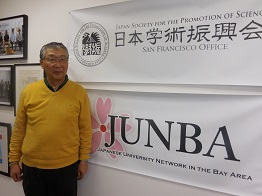
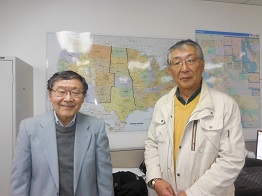
Seminar on Japanese Women in Business: スタンフォードセミナー「日本の女性とビジネス」
@Stanford Univ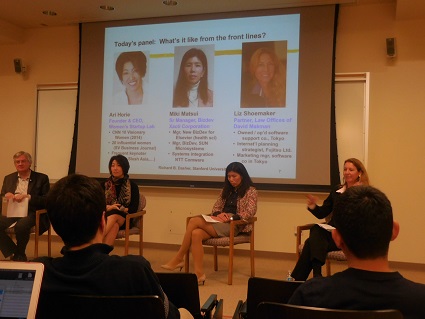
-------------------------------------------------------------------------------
Day 2: February 1(W) ; 2日目:2月1日(水)
Attending two seminars on Japan & China; 日本と中国についてのセミナー参加
Venue: Encina Hall, Stanford University; 場所:スタンフォート大学エンシナホール
Seminar report: セミナー報告: http://miyao-blog.blog.so-net.ne.jp/2017-02-02
Seminar 1) 12:00-1:30pm; セミナー1:12:00-13:30
"Corporate Governance Reform in Japan"; 「日本の企業統治改革」
Speaker: Hideaki Miyajima (Waseda Univ); 宮島英昭早稲田大学教授
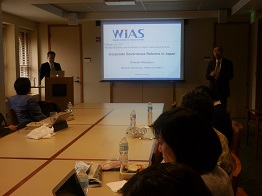
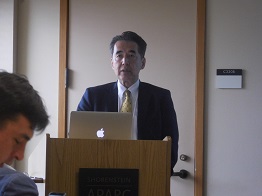
Seminar 2) 4:30-6:00pm; セミナー2: 16:30-18:00
"A 'Comprehensive and Cooperative Partnership'?: China's Role in Latin America";
「包括的で協力的なパートナーシップか?:中南米での中国の役割」
Speaker: Harold Trinkunas (Center for Int'l Security & Cooperation, Stanford)
Moderator/Commentator: Thomas Fingar (FSI, Stanford Univ.)
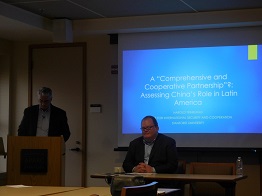
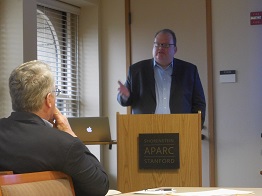
--------------------------------------------------------------------------------
Day 3: February 2(Th) ; 3日目:2月2日(木)
Revisiting Kyushu Univ. Office to meet Mr. Matsuo & visiting Univ. members
九州大学オフィスで松尾代表および訪問中の山田淳九大教授グループと会合
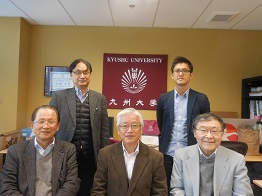
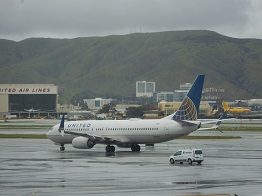
Leaving SFO for LAX in the afternoon: 午後にSF空港発でLAへ
---------------------------------------------------------------------------------
Main purposes: To give a "Certificate of Appreciation" to outgoing JUNBA Chair & Osaka Univ. office head Mr. Kabasawa, and consult with Kyushu Univ. office head Mr. Matsuo about my upcoming debate class for his student group, as well as to attend three Stanford seminars on Japan and China.
訪問の主目的: 間もなくJUNBA(ベイエリア大学ネットワーク)代表と阪大北米センター長の職を退く樺澤氏に「感謝状」を贈呈し、また九大カリフォルニアオフィス代表の松尾氏とディベート実施について相談するとともに、日本と中国に関する3つのスタンフォード大セミナーに参加すること。
Day 1: January 31(T) ; 1日目:1月31日(火)
Revisiting Osaka Univ. Office in SF: 大阪大学北米センター・樺澤氏再訪


Revisiting JSPA Office in Berkeley: JSPSオフィス・田宮氏再訪


Seminar on Japanese Women in Business: スタンフォードセミナー「日本の女性とビジネス」
@Stanford Univ

-------------------------------------------------------------------------------
Day 2: February 1(W) ; 2日目:2月1日(水)
Attending two seminars on Japan & China; 日本と中国についてのセミナー参加
Venue: Encina Hall, Stanford University; 場所:スタンフォート大学エンシナホール
Seminar report: セミナー報告: http://miyao-blog.blog.so-net.ne.jp/2017-02-02
Seminar 1) 12:00-1:30pm; セミナー1:12:00-13:30
"Corporate Governance Reform in Japan"; 「日本の企業統治改革」
Speaker: Hideaki Miyajima (Waseda Univ); 宮島英昭早稲田大学教授


Seminar 2) 4:30-6:00pm; セミナー2: 16:30-18:00
"A 'Comprehensive and Cooperative Partnership'?: China's Role in Latin America";
「包括的で協力的なパートナーシップか?:中南米での中国の役割」
Speaker: Harold Trinkunas (Center for Int'l Security & Cooperation, Stanford)
Moderator/Commentator: Thomas Fingar (FSI, Stanford Univ.)


--------------------------------------------------------------------------------
Day 3: February 2(Th) ; 3日目:2月2日(木)
Revisiting Kyushu Univ. Office to meet Mr. Matsuo & visiting Univ. members
九州大学オフィスで松尾代表および訪問中の山田淳九大教授グループと会合


Leaving SFO for LAX in the afternoon: 午後にSF空港発でLAへ
---------------------------------------------------------------------------------
Stanford Seminars on Japan & China on Feb. 1, 2017 [Report]
Stanford Seminars on Japan and China
Date: February 1(W), 2017
Venue: Philippines Conference Room, Encina Hall, Stanford Univeristy
1) 12:00-1:30pm
"Corporate Governance Reform in Japan": Japan Colloquium Series
Speaker: Hideaki Miyajima (Waseda University)
Moderator/Commentator: Takeo Hoshi (FSI, Stanford University)
(From seminar abstract):
Since Abenomics launched corporate governance reforms as the third arrow of its policies mix, a series of reform measures were introduced such as Stewardship Code, Corporate Governance Code, organizing JPX 400 by Tokyo Stock Exchange. In this presentation, first, recent changes of governance arrangement in Japanese firms are summarized, and some agenda for further reforms is suggested.


Prof. Hideaki Miyajima: http://www.rieti.go.jp/users/miyajima-hideaki/
(English) http://www.rieti.go.jp/users/miyajima-hideaki/index_en.html
(Miyao's report):
Very informative presentation about recent developments in corporate governance reform in Japan. A more detailed account of current issues on this subject matter should be found in Prof. Miyajima's forthcoming book "Corporate Governance and Growth Strategy" (「企業統治と成長戦略」to be published soon, as he pointed out. From the viewpoint of economic theorists like myself, it was quite interesting to hear from him that the current "hybrid" arrangement of Japanese corporate organization, combining the traditional "Japan model" and the "US model" of corporate governance, appears to be stable, contrary to theoretical intuition. Prof. Miyajima did not provide an explanation about this stability property, other than saying that many of the Japanese representative firms seem to have been in some hybrid situation for more than a decade without showing any sign to go to either the purely Japanese or US model. Hopefully in his forthcoming book, at least some more detailed, especially theoretical, account will be presented to persuade both theorists and empiricists on this matter.
2) 4:30-6:00pm
"A 'Comprehensive and Cooperative Partnership'?: Assessing China's Role in Latin America": Asia-Pacific Research Center Event
Speaker: Harold Trinkunas (Center for Int'l Security & Cooperation, Stanford)
Moderator/Commentator: Thomas Fingar (FSI, Stanford Univ.)
(From seminar abstract):
Latin American trade with China has grown exponentially since 2000. Major loans and investments also add to China’s growing role in the region’s economy. China has become an important alternative for capital, trade and technology for Latin America, but without the policy conditionality that regional governments have traditionally experienced in relations with developed countries. As part of a project on China-Latin American relations at the Brookings Institution, Harold Trinkunas assesses how China’s growing economic relations actually influence politics and policies across the region.


Harold Trinkunas: http://cisac.fsi.stanford.edu/people/harold-trinkunas
Thomas Fingar: http://aparc.fsi.stanford.edu/people/thomas_fingar
(Miyao's report):
Very comprehensive and balanced analysis of China's political, economic, and strategic influence in the Latin American region. However, the bottom line conclusion of the speaker's (and the commentator's) argument was something like "China's influence on Latin America in the foreseeable future would be more limited than generally perceived, regardless of what happens to the both Chinese and American sides (even under the Trump administration), in view of the long-term relationship between Latin America and the advanced Western countries, especially the US, still dominating Latin American economies," a view which is not so easily subscribed to by Asian observers like myself, who are more concerned about China's hegemony in Asia and the Pacific-rim region including some Latin American countries, especially in the aftermath of the failure of TPP. as I questioned to these two specialists, who answered my question by saying that the US could effectively deal with Pacific-rim nations even in a bilateral fashion, as US President Trump suggested. We all hope so.
-------------------------------------------------------------------------------------------
Date: February 1(W), 2017
Venue: Philippines Conference Room, Encina Hall, Stanford Univeristy
1) 12:00-1:30pm
"Corporate Governance Reform in Japan": Japan Colloquium Series
Speaker: Hideaki Miyajima (Waseda University)
Moderator/Commentator: Takeo Hoshi (FSI, Stanford University)
(From seminar abstract):
Since Abenomics launched corporate governance reforms as the third arrow of its policies mix, a series of reform measures were introduced such as Stewardship Code, Corporate Governance Code, organizing JPX 400 by Tokyo Stock Exchange. In this presentation, first, recent changes of governance arrangement in Japanese firms are summarized, and some agenda for further reforms is suggested.


Prof. Hideaki Miyajima: http://www.rieti.go.jp/users/miyajima-hideaki/
(English) http://www.rieti.go.jp/users/miyajima-hideaki/index_en.html
(Miyao's report):
Very informative presentation about recent developments in corporate governance reform in Japan. A more detailed account of current issues on this subject matter should be found in Prof. Miyajima's forthcoming book "Corporate Governance and Growth Strategy" (「企業統治と成長戦略」to be published soon, as he pointed out. From the viewpoint of economic theorists like myself, it was quite interesting to hear from him that the current "hybrid" arrangement of Japanese corporate organization, combining the traditional "Japan model" and the "US model" of corporate governance, appears to be stable, contrary to theoretical intuition. Prof. Miyajima did not provide an explanation about this stability property, other than saying that many of the Japanese representative firms seem to have been in some hybrid situation for more than a decade without showing any sign to go to either the purely Japanese or US model. Hopefully in his forthcoming book, at least some more detailed, especially theoretical, account will be presented to persuade both theorists and empiricists on this matter.
2) 4:30-6:00pm
"A 'Comprehensive and Cooperative Partnership'?: Assessing China's Role in Latin America": Asia-Pacific Research Center Event
Speaker: Harold Trinkunas (Center for Int'l Security & Cooperation, Stanford)
Moderator/Commentator: Thomas Fingar (FSI, Stanford Univ.)
(From seminar abstract):
Latin American trade with China has grown exponentially since 2000. Major loans and investments also add to China’s growing role in the region’s economy. China has become an important alternative for capital, trade and technology for Latin America, but without the policy conditionality that regional governments have traditionally experienced in relations with developed countries. As part of a project on China-Latin American relations at the Brookings Institution, Harold Trinkunas assesses how China’s growing economic relations actually influence politics and policies across the region.


Harold Trinkunas: http://cisac.fsi.stanford.edu/people/harold-trinkunas
Thomas Fingar: http://aparc.fsi.stanford.edu/people/thomas_fingar
(Miyao's report):
Very comprehensive and balanced analysis of China's political, economic, and strategic influence in the Latin American region. However, the bottom line conclusion of the speaker's (and the commentator's) argument was something like "China's influence on Latin America in the foreseeable future would be more limited than generally perceived, regardless of what happens to the both Chinese and American sides (even under the Trump administration), in view of the long-term relationship between Latin America and the advanced Western countries, especially the US, still dominating Latin American economies," a view which is not so easily subscribed to by Asian observers like myself, who are more concerned about China's hegemony in Asia and the Pacific-rim region including some Latin American countries, especially in the aftermath of the failure of TPP. as I questioned to these two specialists, who answered my question by saying that the US could effectively deal with Pacific-rim nations even in a bilateral fashion, as US President Trump suggested. We all hope so.
-------------------------------------------------------------------------------------------
2016 Mini-Conference on Disasters and Recovery [Report]
2016 Mini-Conference on Disasters and Recovery@University of Tokyo
Date/Time: December 19, 2016, 9:30am-17:15pm
Place: University of Tokyo, Kojima Hall, Seminar Room No. 1
Organizers:
Yasuyuki Sawada, Univ. of Tokyo and Daniel P. Aldrich, Northeastern Univ.
Program:
9:30-9:40 Conference Welcome from Prof. Yasuyuki Sawada
Session 1: 9:40-12:10 Chair, Yasuyuki Sawada
(Left) Toru Tsuboya, Tohoku Univ. "Types of disaster damage and change in depressive symptoms among survivors in Iwanuma, Miyagi"; (Right) Naoki Kondo, Tokyo Univ. "Disasters, economic crisis and social capital: evidence from social epidemiology"
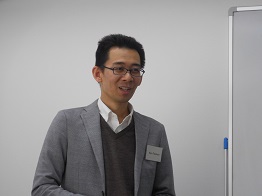
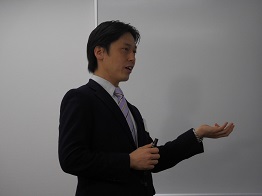
(Left) Daniel Aldrich, Northeastern Univ. "How social capital matters during and after disasters"; (Right) Q&A session
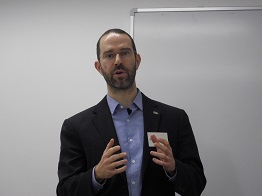
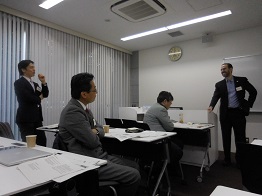
Session 2; 12:50-17:15 Chair, Daniel P. Aldrich
(Left) Jamie Lien, Chinese Univ. of Hong Kong, "Major earthquake experiences and presently-focused expenditures"; (Right) Yuki Higuchi, Nagoya City Univ. "Disaster aid targeting and political connection: Evidence from the Philippines"
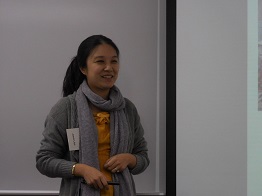
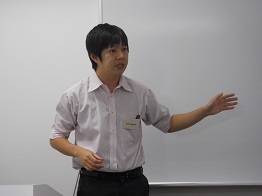
(Left) Yasuyuki Sawada, Tokyo Univ. "Disaster and preference: A united thery and evidence from the Philippines and Japan"; (Right) Masaharu Tsubokura, Tokyo Univ. "Medical assistance for the 23km zone after the Fukushima Dai-ichi nuclear disaster"
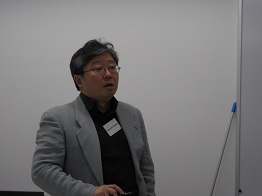
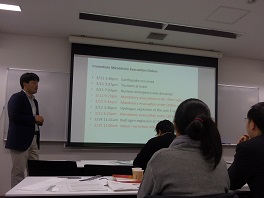
(Left) Minhaj Mahmud, BRAC Univ., "Natural disaster and risk sharing behavior: Experimental evidence from Bangladesh”; (Right) Yasuyuki Sawada, Tokyo Univ., Closing Remarks
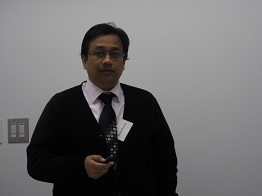
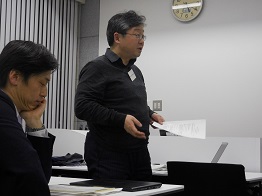
---------------------------------------------------------------------------------------------
Date/Time: December 19, 2016, 9:30am-17:15pm
Place: University of Tokyo, Kojima Hall, Seminar Room No. 1
Organizers:
Yasuyuki Sawada, Univ. of Tokyo and Daniel P. Aldrich, Northeastern Univ.
Program:
9:30-9:40 Conference Welcome from Prof. Yasuyuki Sawada
Session 1: 9:40-12:10 Chair, Yasuyuki Sawada
(Left) Toru Tsuboya, Tohoku Univ. "Types of disaster damage and change in depressive symptoms among survivors in Iwanuma, Miyagi"; (Right) Naoki Kondo, Tokyo Univ. "Disasters, economic crisis and social capital: evidence from social epidemiology"


(Left) Daniel Aldrich, Northeastern Univ. "How social capital matters during and after disasters"; (Right) Q&A session


Session 2; 12:50-17:15 Chair, Daniel P. Aldrich
(Left) Jamie Lien, Chinese Univ. of Hong Kong, "Major earthquake experiences and presently-focused expenditures"; (Right) Yuki Higuchi, Nagoya City Univ. "Disaster aid targeting and political connection: Evidence from the Philippines"


(Left) Yasuyuki Sawada, Tokyo Univ. "Disaster and preference: A united thery and evidence from the Philippines and Japan"; (Right) Masaharu Tsubokura, Tokyo Univ. "Medical assistance for the 23km zone after the Fukushima Dai-ichi nuclear disaster"


(Left) Minhaj Mahmud, BRAC Univ., "Natural disaster and risk sharing behavior: Experimental evidence from Bangladesh”; (Right) Yasuyuki Sawada, Tokyo Univ., Closing Remarks


---------------------------------------------------------------------------------------------
日本人学生の課題と解決策:JUNBAメンバー聞き取り調査結果と提言 [報告]
日本人学生に関する課題と解決策:JUNBAメンバー聞き取り調査結果と提言
宮尾尊弘(筑波大学名誉教授)
聞き取りの時期:2016年10月18日~10月20日
対象:JUNBA(サンフランシスコ・ベイエリア大学連携ネットワーク)メンバー:
http://www.junba.org/
聞き取りを行ったJUNBAメンバー大学関係のオフィス(訪問順):
10月18日(火):
1. 日本学術振興会サンフランシスコ研究連絡センター
2. 龍谷大学バークレーセンターRUBeC
3. 早稲田大学サンフランシスコオフィスki
4. 大阪大学北米センター
10月20日(木):
5. 九州大学カリフォルニアオフィス
6. 福岡工業大学カリフォルニア事務所
聞き取りの際の質問事項:
「日本からそちらに研修に来る学生たちが持つ一番の問題点は何でしょうか」
英語力なのか、論理的思考力なのか、意欲の問題なのか、文化的な違いなのか、学問的な準備の問題なのでしょうか。
質問への答:
「日本人学生が持つ一番の問題は、学生が自分の考えを表現し、発言や発表ができないこと」
理由と背景:
この問題がいつまでも解決されない理由は、以下の2つに大別される:
1) 文化(心理)的な理由(発言を奨励する文化と抑制する文化の差が大きい)
2) 表現上(英語)の理由(発言・発表の仕方が特に英語では分からない)
以上の2点にそれぞれ答える提言・マニュアルは以下の通り。
---------------------------------------------------------------------------------
1: 文化(心理)的な問題の解決策:提言
文化(心理)的な理由(発言を奨励する文化と抑制する文化の差が大きい)
背景:
日本人学生たちの自己評価が低く、自分に自信が持てない。そのために他者やその場の自分への評価を気にしすぎ、「場違い」な発言をしないよう抑制してしまう。
(他方、米国人の学生たちは自己評価が高く、自信をもってどんな場でも発言する)
課題:
この逆の方向性をもつ2つの文化差をどう乗り越えて、学生たちが進んで発言するような心理状態にどう持っていくか
文化(心理)的な問題克服への提言:
A) 個人レベルの対策:
1: 日米では発言や発表についての文化(評価)差があることをよく分からせる。
2: 参加した活動について自分を評価する点と反省する点を客観的に書かせる。
3: 自分の発言を録音させて、それを聞いて自ら良かった点と反省点を分らせる。
B) 仲間・友人レベルの対策:
1: 仲間や友人どうしでお互いの長所や良い点などを話し合うように奨励する。
2: 「他己紹介」などによって、自らが客観的にどう見られているかを知らせる。
3: 米国人の友人を作らせて、発言・発表の態度や方法の違いを分からせる。
C) 大学レベルの対策:
1: 大学や教員や職員がすべて自分たちに自信と誇りをもち(特に縦のランキングでなく、横の特長
や独自性について)、常に学生たちに伝えるようにする。
2: 大学レベルで発言・発表などによる参加態度を評価するシステムを作る。
3: 海外で学生たちの心理状態をモニターして、必要ならばカウンセリングを行う。
-----------------------------------------------------------------------------------
2: 英語表現上の問題の解決策:マニュアル
表現上(英語)の理由(発言・発表の仕方が特に英語では分からない)
マニュアル:日本人学生のための手引き案
I . 質問のしかた:「どのように質問したらいいでしょうか」
Ia. 段階1:一番簡単にできる質問
例:「その・・・・・についてもう少し説明していただけますか」
“Could you please explain a little more about…….?”
(このような相手により詳しい説明を求める”clarifying questions”は、アメリカでは相手が発言や発表をしている最中でも許される)
Ib. 段階2:次に簡単でよくなされる質問
例:「そちらのお話に関連して、….についてはどうお考えですか」
“In relation to what you said, what do you think about……”
(できるだけ相手の話に関連があって皆が興味を持つ問題に触れるのがよい)
Ic. 段階3:ある程度準備が必要だが「実のある」質問
例:「そちらの主張に対して、…..という反対意見がありますがどう思われますか」
“What do you think of a counter-argument to your opinion like……?” or
“What do you think about an argument contrary to what you said like…”
(相手の主張や意見は何か、そしてその反対意見は何かを前もって調べる必要)
→ ディベートで意見を戦わせる際にも必要な準備。
II. 「質問」する際に注意しましょう
IIa. 注意点1:「準備」が大切
最初から質問しようと心の準備をしておき、相手の話で上の質問をからませる内容・結論をよく理解すること(表現方法は上記に従い、内容に集中して理解と質問する)
IIb. 注意点2:「見栄え」が大切
人に先がけてさっと手を上げ、指名されたら立って姿勢をよくして、大きな声を出す。
(恐る恐る小さな声で「すみませんが・・・」(sorryとかexcuse me)ということは禁物、
IIc. 注意点3:「形式」(礼儀・プロトコール)が大切
まず自分の名前と所属を言い、相手に敬意を払う「おせじ」を言ってから質問する。
最初に:「今日はすばらしいお話をありがとうございました。大変勉強になりました」
“Thank you very much for your great presentation today. I learned a lot.”
III. 発表のしかた:「どのように発表したらいいでしょうか」
IIIa. 準備1:発表の「ポイント(結論)」を最初に明確にする
例:「私は・・・・についてお話します。主な結論は・・・・です。」
“I would like to talk about……and my main point (conclusion) is…...”
(発表は重要なことから先に言い、結論を出す過程を順番に説明するのでない。そうすれば数分の短い発表でも、1時間の長い発表でも、重要な結論から言えばすむ。)
IIIb. 準備2:自分の発表内容の「独自性」を強調する
例:「私の議論(分析)は・・・・です。一方これまでの議論(分析)は・・・・です。」
“My argument (analysis) is…, while the existing argument (analysis) is..”
(自分の発表内容がこれまでの意見・分析と違う点を指摘して、その後で説明する)
IIIc. 準備3:自分の「主観的」な意見・解釈と「客観的」な事実・分析を分ける
例:「私の意見が他の人と異なるのは客観的なデータの解釈が異なるからです。」
“My opinion is different from others, as my interpretation of the existing data is different.”
(客観的データの収集や分析で他者との違いを出すのは難しいが、解釈の違いで独自な結論を導くことは比較的容易。ただしなぜそのように解釈するかの説明が重要)
IV. 「発表」する際に注意しましょう
IVa. 注意点1:「コミュニケーション」が大切
発表は参加者との「コミュニケーション」と心得て、配布資料やパワーポイントなどは必要最小限の使用と内容にして、文章を読むのでなく、皆の顔を見て話しかける。
(これまで世界一と称賛されたパワーポイントの内容はたった「単語一つ」!)
IVb. 注意点2:「パフォーマンス」が大切
発表は1対1の対話ではなく、1対大勢の「公式」の場なので、舞台の上でのパフォーマンスと心得て、正しい姿勢で大きな声でジェスチャーなどを加えて演技をする。
(「質問」の注意点IIb「見栄えが大切」と同じ、日本人はこの意識が薄いので注意)
IVc. 注意点3:「プロトコール」(形式・礼儀)が大切
最初に主催者や紹介者にお礼を言い、最後には参加者全員に謝意を表すること。
最初の謝辞:「・・・様(先生)、ご親切なお招き(ご紹介)ありがとうございました」
“Thank you very much, Mr (Prof)…, for your kind invitation (introduction)”
(以上)
----------------------------------------------------------------------------------
宮尾尊弘(筑波大学名誉教授)
聞き取りの時期:2016年10月18日~10月20日
対象:JUNBA(サンフランシスコ・ベイエリア大学連携ネットワーク)メンバー:
http://www.junba.org/
聞き取りを行ったJUNBAメンバー大学関係のオフィス(訪問順):
10月18日(火):
1. 日本学術振興会サンフランシスコ研究連絡センター
2. 龍谷大学バークレーセンターRUBeC
3. 早稲田大学サンフランシスコオフィスki
4. 大阪大学北米センター
10月20日(木):
5. 九州大学カリフォルニアオフィス
6. 福岡工業大学カリフォルニア事務所
聞き取りの際の質問事項:
「日本からそちらに研修に来る学生たちが持つ一番の問題点は何でしょうか」
英語力なのか、論理的思考力なのか、意欲の問題なのか、文化的な違いなのか、学問的な準備の問題なのでしょうか。
質問への答:
「日本人学生が持つ一番の問題は、学生が自分の考えを表現し、発言や発表ができないこと」
理由と背景:
この問題がいつまでも解決されない理由は、以下の2つに大別される:
1) 文化(心理)的な理由(発言を奨励する文化と抑制する文化の差が大きい)
2) 表現上(英語)の理由(発言・発表の仕方が特に英語では分からない)
以上の2点にそれぞれ答える提言・マニュアルは以下の通り。
---------------------------------------------------------------------------------
1: 文化(心理)的な問題の解決策:提言
文化(心理)的な理由(発言を奨励する文化と抑制する文化の差が大きい)
背景:
日本人学生たちの自己評価が低く、自分に自信が持てない。そのために他者やその場の自分への評価を気にしすぎ、「場違い」な発言をしないよう抑制してしまう。
(他方、米国人の学生たちは自己評価が高く、自信をもってどんな場でも発言する)
課題:
この逆の方向性をもつ2つの文化差をどう乗り越えて、学生たちが進んで発言するような心理状態にどう持っていくか
文化(心理)的な問題克服への提言:
A) 個人レベルの対策:
1: 日米では発言や発表についての文化(評価)差があることをよく分からせる。
2: 参加した活動について自分を評価する点と反省する点を客観的に書かせる。
3: 自分の発言を録音させて、それを聞いて自ら良かった点と反省点を分らせる。
B) 仲間・友人レベルの対策:
1: 仲間や友人どうしでお互いの長所や良い点などを話し合うように奨励する。
2: 「他己紹介」などによって、自らが客観的にどう見られているかを知らせる。
3: 米国人の友人を作らせて、発言・発表の態度や方法の違いを分からせる。
C) 大学レベルの対策:
1: 大学や教員や職員がすべて自分たちに自信と誇りをもち(特に縦のランキングでなく、横の特長
や独自性について)、常に学生たちに伝えるようにする。
2: 大学レベルで発言・発表などによる参加態度を評価するシステムを作る。
3: 海外で学生たちの心理状態をモニターして、必要ならばカウンセリングを行う。
-----------------------------------------------------------------------------------
2: 英語表現上の問題の解決策:マニュアル
表現上(英語)の理由(発言・発表の仕方が特に英語では分からない)
マニュアル:日本人学生のための手引き案
I . 質問のしかた:「どのように質問したらいいでしょうか」
Ia. 段階1:一番簡単にできる質問
例:「その・・・・・についてもう少し説明していただけますか」
“Could you please explain a little more about…….?”
(このような相手により詳しい説明を求める”clarifying questions”は、アメリカでは相手が発言や発表をしている最中でも許される)
Ib. 段階2:次に簡単でよくなされる質問
例:「そちらのお話に関連して、….についてはどうお考えですか」
“In relation to what you said, what do you think about……”
(できるだけ相手の話に関連があって皆が興味を持つ問題に触れるのがよい)
Ic. 段階3:ある程度準備が必要だが「実のある」質問
例:「そちらの主張に対して、…..という反対意見がありますがどう思われますか」
“What do you think of a counter-argument to your opinion like……?” or
“What do you think about an argument contrary to what you said like…”
(相手の主張や意見は何か、そしてその反対意見は何かを前もって調べる必要)
→ ディベートで意見を戦わせる際にも必要な準備。
II. 「質問」する際に注意しましょう
IIa. 注意点1:「準備」が大切
最初から質問しようと心の準備をしておき、相手の話で上の質問をからませる内容・結論をよく理解すること(表現方法は上記に従い、内容に集中して理解と質問する)
IIb. 注意点2:「見栄え」が大切
人に先がけてさっと手を上げ、指名されたら立って姿勢をよくして、大きな声を出す。
(恐る恐る小さな声で「すみませんが・・・」(sorryとかexcuse me)ということは禁物、
IIc. 注意点3:「形式」(礼儀・プロトコール)が大切
まず自分の名前と所属を言い、相手に敬意を払う「おせじ」を言ってから質問する。
最初に:「今日はすばらしいお話をありがとうございました。大変勉強になりました」
“Thank you very much for your great presentation today. I learned a lot.”
III. 発表のしかた:「どのように発表したらいいでしょうか」
IIIa. 準備1:発表の「ポイント(結論)」を最初に明確にする
例:「私は・・・・についてお話します。主な結論は・・・・です。」
“I would like to talk about……and my main point (conclusion) is…...”
(発表は重要なことから先に言い、結論を出す過程を順番に説明するのでない。そうすれば数分の短い発表でも、1時間の長い発表でも、重要な結論から言えばすむ。)
IIIb. 準備2:自分の発表内容の「独自性」を強調する
例:「私の議論(分析)は・・・・です。一方これまでの議論(分析)は・・・・です。」
“My argument (analysis) is…, while the existing argument (analysis) is..”
(自分の発表内容がこれまでの意見・分析と違う点を指摘して、その後で説明する)
IIIc. 準備3:自分の「主観的」な意見・解釈と「客観的」な事実・分析を分ける
例:「私の意見が他の人と異なるのは客観的なデータの解釈が異なるからです。」
“My opinion is different from others, as my interpretation of the existing data is different.”
(客観的データの収集や分析で他者との違いを出すのは難しいが、解釈の違いで独自な結論を導くことは比較的容易。ただしなぜそのように解釈するかの説明が重要)
IV. 「発表」する際に注意しましょう
IVa. 注意点1:「コミュニケーション」が大切
発表は参加者との「コミュニケーション」と心得て、配布資料やパワーポイントなどは必要最小限の使用と内容にして、文章を読むのでなく、皆の顔を見て話しかける。
(これまで世界一と称賛されたパワーポイントの内容はたった「単語一つ」!)
IVb. 注意点2:「パフォーマンス」が大切
発表は1対1の対話ではなく、1対大勢の「公式」の場なので、舞台の上でのパフォーマンスと心得て、正しい姿勢で大きな声でジェスチャーなどを加えて演技をする。
(「質問」の注意点IIb「見栄えが大切」と同じ、日本人はこの意識が薄いので注意)
IVc. 注意点3:「プロトコール」(形式・礼儀)が大切
最初に主催者や紹介者にお礼を言い、最後には参加者全員に謝意を表すること。
最初の謝辞:「・・・様(先生)、ご親切なお招き(ご紹介)ありがとうございました」
“Thank you very much, Mr (Prof)…, for your kind invitation (introduction)”
(以上)
----------------------------------------------------------------------------------
Visit to SF Bay Area (Oct. 18-20): SFベイエリア訪問(10月18日~20日) [Photos/写真]
Visit to SF Bay Area (Oct. 18-20): SFベイエリア訪問(10月18日~20日)
Day 1: October 18(T) ; 1日目:10月18日(火)
Visiting Berkeley; バークレー訪問
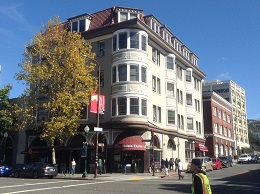
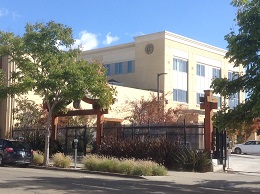
Visits: JSPS SF Office; 日本学術振興会オフィス(http://www.jspsusa-sf.org/)
Ryukoku Univ. Office; 龍谷大オフィス
(http://www.ryukoku.ac.jp/about/campus_traffic/rubec.html)
From Berkeley to Downtown SF; バークレーからダウンタウンSFへ
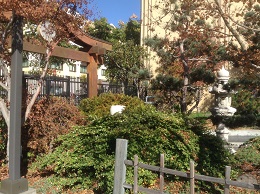
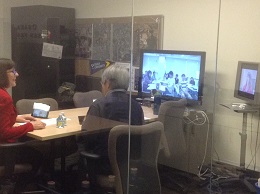
Visits: Osaka Univ. Office; 大阪大オフィス:遠隔講義 (http://osaka-u-sf.org/ja/)
Waseda Univ. Office; 早大オフィス (https://www.waseda.jp/inst/us-office/)
------------------------------------------------------------------------------------------
Day 2: October 19(W); 2日目:10月19日(水)
Visiting Stanford University; スタンフォード大学訪問

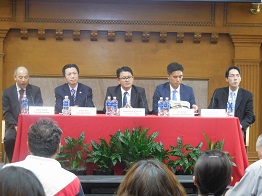
Stanford Seminar: セミナー参加:http://miyao-blog.blog.so-net.ne.jp/2016-10-20
Back to Downtown SF/JapanTown; ダウンタウンSFのジャパンタウン
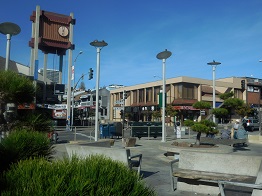
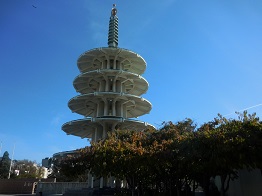
----------------------------------------------------------------------------------------
Day 3: October 20 (Th); 3日目:10月20日(木)
Drive down to San Jose (Campbell) ; サンノゼ(キャンベル)へ
Visit: Kyushu Univ. Office; 九州大オフィス
(http://www.isc.kyushu-u.ac.jp/california/)
Drive up to Alameda; アラミダへ

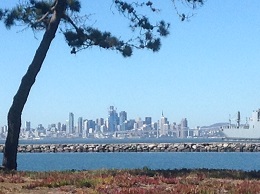
Visit: Fukuoka Inst. of Tech; 福岡工大オフィス
(http://www.fit.ac.jp/kyoiku/kokusai/network)
----------------------------------------------------------------------------------------
Day 1: October 18(T) ; 1日目:10月18日(火)
Visiting Berkeley; バークレー訪問


Visits: JSPS SF Office; 日本学術振興会オフィス(http://www.jspsusa-sf.org/)
Ryukoku Univ. Office; 龍谷大オフィス
(http://www.ryukoku.ac.jp/about/campus_traffic/rubec.html)
From Berkeley to Downtown SF; バークレーからダウンタウンSFへ


Visits: Osaka Univ. Office; 大阪大オフィス:遠隔講義 (http://osaka-u-sf.org/ja/)
Waseda Univ. Office; 早大オフィス (https://www.waseda.jp/inst/us-office/)
------------------------------------------------------------------------------------------
Day 2: October 19(W); 2日目:10月19日(水)
Visiting Stanford University; スタンフォード大学訪問


Stanford Seminar: セミナー参加:http://miyao-blog.blog.so-net.ne.jp/2016-10-20
Back to Downtown SF/JapanTown; ダウンタウンSFのジャパンタウン


----------------------------------------------------------------------------------------
Day 3: October 20 (Th); 3日目:10月20日(木)
Drive down to San Jose (Campbell) ; サンノゼ(キャンベル)へ
Visit: Kyushu Univ. Office; 九州大オフィス
(http://www.isc.kyushu-u.ac.jp/california/)
Drive up to Alameda; アラミダへ


Visit: Fukuoka Inst. of Tech; 福岡工大オフィス
(http://www.fit.ac.jp/kyoiku/kokusai/network)
----------------------------------------------------------------------------------------
Stanford Event: Nuclear Safety And Security In Northeast Asia: A Panel Discussion [Report]
Nuclear Safety And Security In Northeast Asia: A Panel Discussion (October 19, 2016)
Sponsored by: Shorenstein Asia-Pacific Research Center
Date/Time: October 19(W), 12:00-1:30pm
Venue: Bechtel Conference Center, Encina Hall, Stanford
Moderator:
Takeo Hoshi, Henri H. and Tomoye Takahashi Senior Fellow in Japanese Studies, Freeman Spogli Institute for International Studies
Panelists:
Liyou Zha, Deputy Consul General of the People Public of China, San Francisco
Shouichi Nagayoshi, Deputy Consul General of Japan, San Francisco
Jimin Kim, Deputy Consul General of the Republic of Korea, San Francisco
Phillip Lipscy, TheThomas Rohlen Center Fellow, Freeman Spogli Institute for International Studies, Associate Professor of Political Science
Photo:
Prof. T. Hoshi, Mr. L. Zha, Mr. S. Nagayoshi, Mr. J. Kim and Prof. P. Lipscy
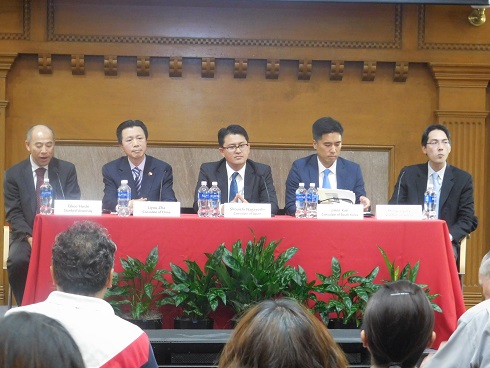
Webpage: https://events.stanford.edu/events/628/62811/
"Northeast Asia is now a central arena to determine the future of nuclear safety and security. The Fukushima nuclear accident, and its ongoing aftermath, is at the forefront of the debate over the utility of nuclear energy in resolving global issues of climate change and energy security. And North Korea’s headlong rush towards acquisition of nuclear weapons and delivery systems has sparked talk of going nuclear in both South Korea and China and discussion over how to provide extended deterrence, including the role of missile defense."
Review:
When diplomats stationing in a local city like San Francisco talk about national and international issues such as nuclear safety and security, all you can expect is what may be called "diplomatic talks." It was no exception this time, as the three diplomats claimed that their governments were doing their best in achieving "nuclear safety and security" by cooperating among the three countries, even in dealing with the "trust deficit" issue about nuclear safety and the "North Korea" issue about nuclear security.
Whenever they had to mention some unresolved problems, the key word "challenge" was used to avoid admission of inabilities or even failures in addressing such problems.
It turned out to be so obviously "diplomatic," when the three deputy consuls responded to the question from the floor, asking how their governments are dealing with the public's strong opposition to nuclear power, that is, the problem of seemingly increasing trust deficit: the Korean deputy consul said something like "educating people," and the Japanese deputy consul emphasized "dialogue with the public," while the Chinese deputy consul somewhat surprisingly that "the government listens and can change its mind in building nuclear plants," although that could happen only in some neighborhoods, but certainly not for the nation as a whole, as the Chinese diplomat himself initially presented that there were 27 nuclear power plants currently in operation, and 25 more under construction, which looks like a very aggressive pro-nuclear power policy.
Prof. Lipscy raised an interesting point regarding the possible implications of changing political atmosphere and shifting public opinions in the US regarding nuclear proliferation in Asia, but unfortunately there was no response from any panelist or even from the floor. Probably, we need another round of panel discussion, preferably by specialists, on such an issue.
(T. Miyao)
References:
Stanford Colloquium:Japan's Great Earthquake & Nuclear Disaster: 5 Years Later" (March 10, 2016)
http://miyao-blog.blog.so-net.ne.jp/2016-03-11
--------------------------------------------------------------------------------------------
Sponsored by: Shorenstein Asia-Pacific Research Center
Date/Time: October 19(W), 12:00-1:30pm
Venue: Bechtel Conference Center, Encina Hall, Stanford
Moderator:
Takeo Hoshi, Henri H. and Tomoye Takahashi Senior Fellow in Japanese Studies, Freeman Spogli Institute for International Studies
Panelists:
Liyou Zha, Deputy Consul General of the People Public of China, San Francisco
Shouichi Nagayoshi, Deputy Consul General of Japan, San Francisco
Jimin Kim, Deputy Consul General of the Republic of Korea, San Francisco
Phillip Lipscy, TheThomas Rohlen Center Fellow, Freeman Spogli Institute for International Studies, Associate Professor of Political Science
Photo:
Prof. T. Hoshi, Mr. L. Zha, Mr. S. Nagayoshi, Mr. J. Kim and Prof. P. Lipscy

Webpage: https://events.stanford.edu/events/628/62811/
"Northeast Asia is now a central arena to determine the future of nuclear safety and security. The Fukushima nuclear accident, and its ongoing aftermath, is at the forefront of the debate over the utility of nuclear energy in resolving global issues of climate change and energy security. And North Korea’s headlong rush towards acquisition of nuclear weapons and delivery systems has sparked talk of going nuclear in both South Korea and China and discussion over how to provide extended deterrence, including the role of missile defense."
Review:
When diplomats stationing in a local city like San Francisco talk about national and international issues such as nuclear safety and security, all you can expect is what may be called "diplomatic talks." It was no exception this time, as the three diplomats claimed that their governments were doing their best in achieving "nuclear safety and security" by cooperating among the three countries, even in dealing with the "trust deficit" issue about nuclear safety and the "North Korea" issue about nuclear security.
Whenever they had to mention some unresolved problems, the key word "challenge" was used to avoid admission of inabilities or even failures in addressing such problems.
It turned out to be so obviously "diplomatic," when the three deputy consuls responded to the question from the floor, asking how their governments are dealing with the public's strong opposition to nuclear power, that is, the problem of seemingly increasing trust deficit: the Korean deputy consul said something like "educating people," and the Japanese deputy consul emphasized "dialogue with the public," while the Chinese deputy consul somewhat surprisingly that "the government listens and can change its mind in building nuclear plants," although that could happen only in some neighborhoods, but certainly not for the nation as a whole, as the Chinese diplomat himself initially presented that there were 27 nuclear power plants currently in operation, and 25 more under construction, which looks like a very aggressive pro-nuclear power policy.
Prof. Lipscy raised an interesting point regarding the possible implications of changing political atmosphere and shifting public opinions in the US regarding nuclear proliferation in Asia, but unfortunately there was no response from any panelist or even from the floor. Probably, we need another round of panel discussion, preferably by specialists, on such an issue.
(T. Miyao)
References:
Stanford Colloquium:Japan's Great Earthquake & Nuclear Disaster: 5 Years Later" (March 10, 2016)
http://miyao-blog.blog.so-net.ne.jp/2016-03-11
--------------------------------------------------------------------------------------------



